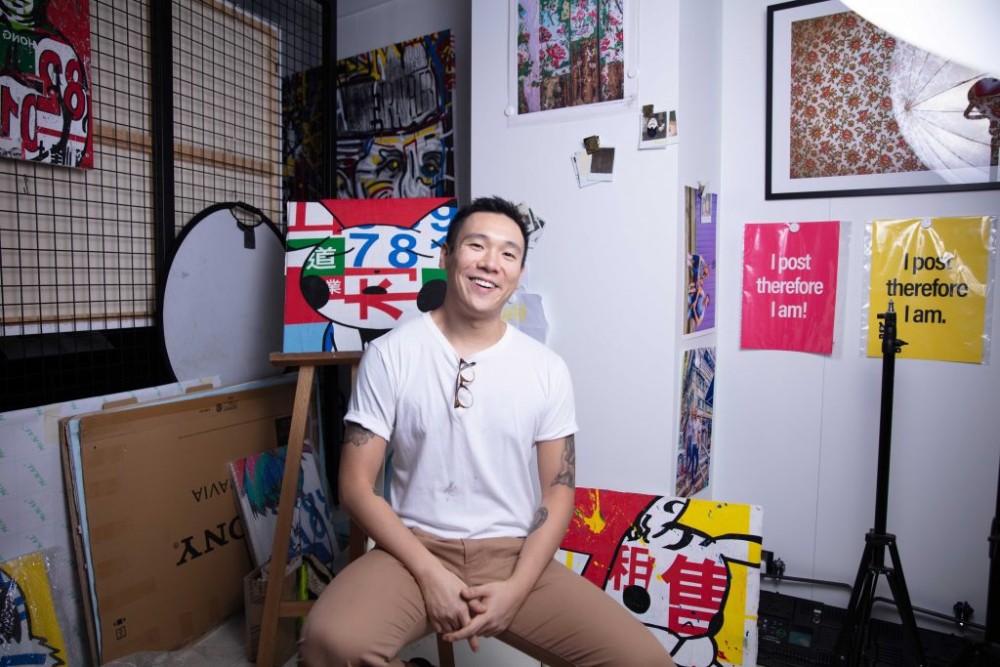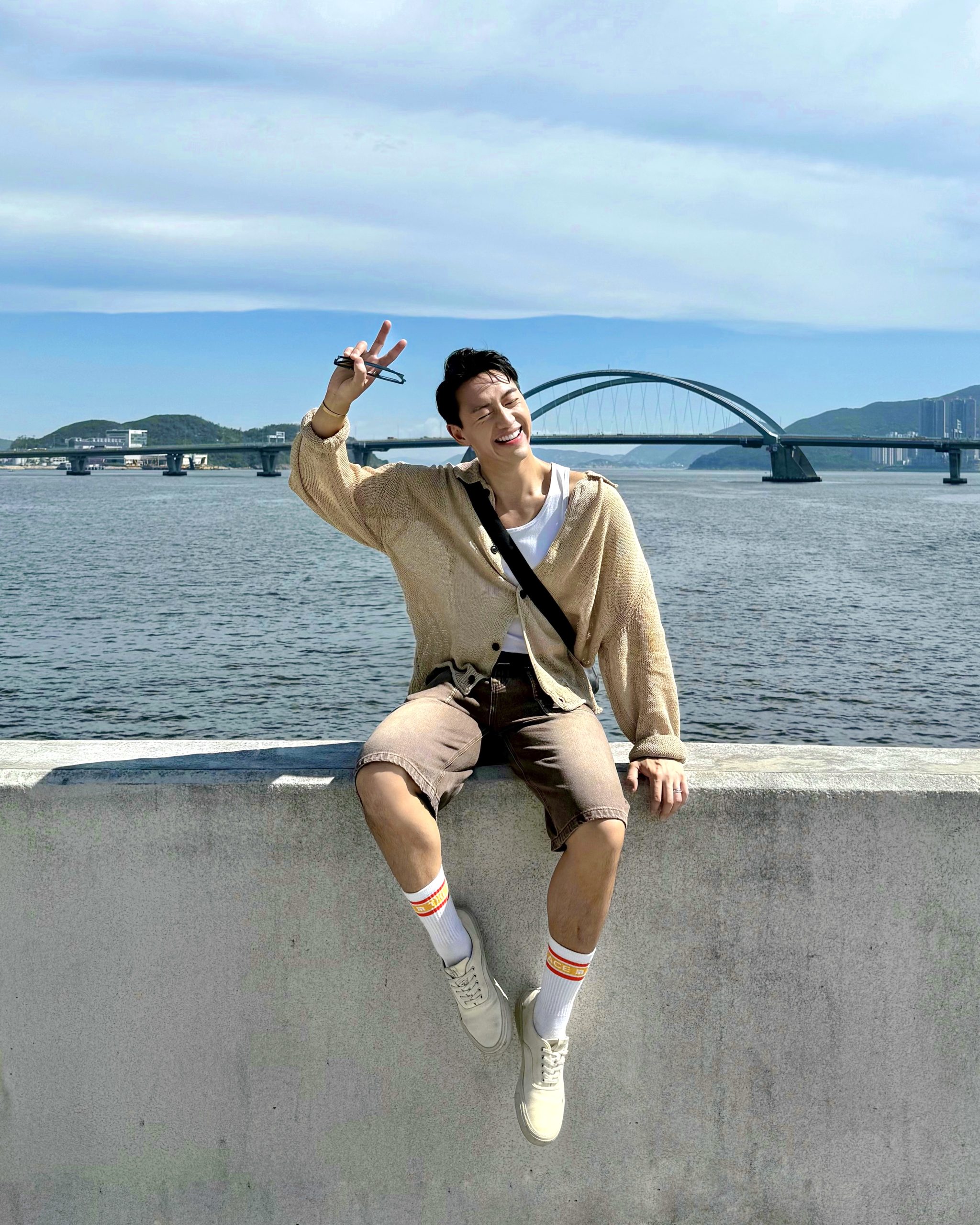
Growing up in a few different cities, it’s easy to get lost in your own identity. For Ernest Chang, a Hong Kong-based artist who has battled through a variety of issues, from red-green colour blindness to the pressure of blending into modern society, he has found a way to express himself through his photography, portraits and paintings. We sat down with Chang in The Stallery, his gallery in the heart of Wan Chai, to discuss his evolution as an artist and his journey to get to his current collection, “Famous by Proxy“.

You were born in the States. What made you decide to relocate back to Hong Kong?
It’s because my parents are from Hong Kong and I went to high school here, so it automatically made me want to come back to surroundings that I’m the most comfortable with. But mainly it’s because I had an episode in rehab. I went to rehab in Bangkok and it’s really close to Hong Kong, so I decided to come back to find a purpose again in life.
Your main focus was on photography and graphic design. What gave you the push to start painting?
I think I’ve always liked painting, but I’m colour blind, so I can’t see red and green. In art classes, I always had a problem painting realistic objects; therefore, it’s a lot easier for me to use ready-made items to express myself. But recently, I’ve seen a lot more development in visual art for digital painting. That’s the push that made me start to paint on the computer again, because of all the external tools nowadays. I start off by sketching digitally on my iPad, then separate all the layers from the colours and continue on with silkscreens.
Why comics and anime?
Mainly it’s because I love to challenge what fine art means to the audience, even though Andy Warhol and Roy Lichtenstein have done it. But I feel like there’s a lack of understanding of what pop art is – and there’s a lot more to express through pop art with all the new mediums to make art.

On the topic of comics and anime, tell us about your major pop-culture inspirations.
There’s a few right now, especially for this series. For example, Roy Lichtenstein is a huge impact, and Jean Dubuffet. They both had this style where they are both super-pop, but at the same time, there’s this experimentation in how comics and pop-art can become fine art. And I feel like that’s what I’m trying to challenge as well. Just using very pop compositions and pop art, but then still saving the integrity of a Renaissance painting, and mixing it with something that is older – people value this more for some reason.
I stumbled upon your work last year when you did mostly Pokemon-related art. How do you come up with these concepts?
Last year, most of the inspiration came from my surroundings, which is Wan Chai. I’ve lived and worked here for the past five years, and I saw these people playing Pokemon Go. I understand the urge to want to collect them all and express it with this idea of when we were children, we were fed to collect Pokemon – ultimately, in adult life, we were fed to collect another sort of consumer items. And the idea also came in when I saw all these for-rent signs getting ripped up. That gave me the idea of people being able to rip the paintings apart. And this also links back to the idea of consumerism, where once you consume the item, it’s gone. I was just trying to encapsulate consumerism in a contemporary form.
Among all your work, which one is your favourite?
My favorite piece has to be the Mario from this series. It’s the first piece of art that I did on this series and it took me more than eight months to finish the whole sketch. Ultimately, there are 18 colours and three panels; it’s super difficult to achieve and I’m very proud of myself with the piece. It’s a huge challenge, as I see [Takashi] Murakami doing it, but he has a huge team to help him out and I only have one assistant. With only two people, it’s very difficult to achieve this high-quality art when you have few resources.

I read in your bio that you’re investigating the impact of technology on contemporary society. Can you elaborate more on that?
With the series I’ve been recently creating, the goal for each piece is to be seen on both social media platforms and also in real life. So if you photograph any of my works from the past two years, you’ll be able to see it and enjoy it on social media as well. With all these techniques, even if you zoom in on them on your phone, it opens up a conversation where you would like to see it in real life – to see how these techniques were done in person. That’s why I keep posting and uploading the process of making this art on my own social media platforms. I’m also interested in how Instagram feeds you content; the more graphic, the more interaction you’ll get as an artist. That’s also one of the factors that I’ve been playing with – the algorithm on Instagram that’s ever-changing.
What is the message or feeling you hope people can get after seeing your pieces?
I want the audience to know that despite the fact that it looks flat and simple to draw, the process takes more work than it looks. If you see it in real life, you see the wood, the manual printing process and the gaps in-between the ink, where there are human-made flaws. Most of the time when they see it on social media, it looks like a graphic print, but if you see it in real life up close, there are layers put into the pieces.
Is your personal life reflected in your art?
My personal life was a lot more influential in my work a few years ago. Now my personal life is this art. I feel like I’m constantly going to museums to see different types of work from other artists and trying to encapsulate in this form. Before, I went through periods where I was unhappy and it shows. But I’m happy now at this moment and I feel like there’s a different feeling to my art. It’s more to show people that even though people look happy on the outside, it’s okay to change within yourself. I feel like that’s a question I get a lot as an artist: why do I always have a constant change in my style all the time? It’s because I feel different.
Who’s your true #legend?
The most life-changing thing that happened to me was reading On the Road by Jack Kerouac. I felt like it’s the most amusing event that a teenager could do – just hop on a train and be a hobo for a while, and live a bit in the country. I feel like that’s the moment where I changed my perception on how to view and explore the world. Before this book, I didn’t think I could achieve what I’ve achieved thus far in my life.













